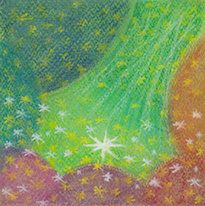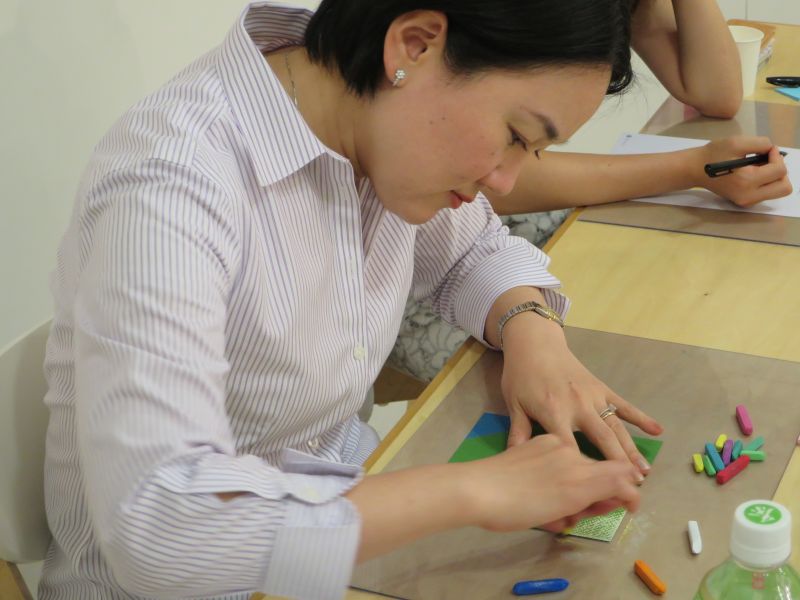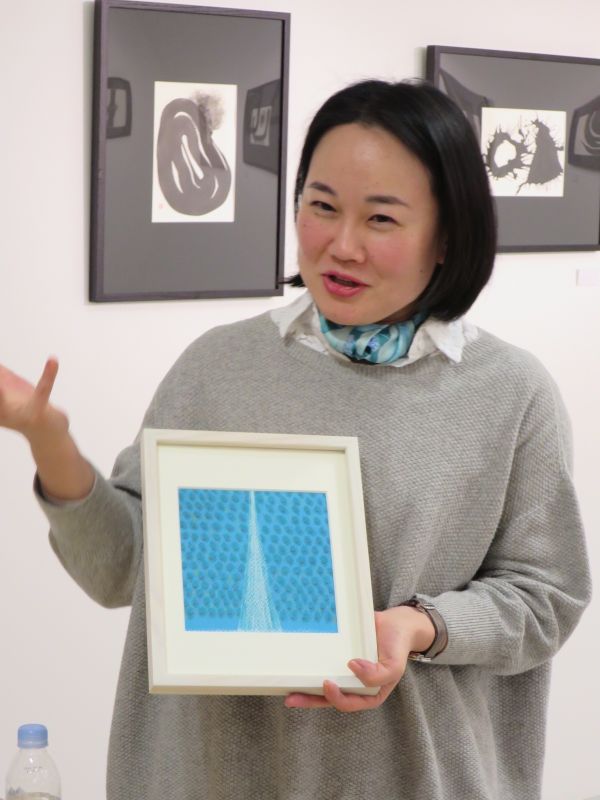Painting allows me to take a step back and see myself

Painting allows me to take a step back and see myself
Even I’ve been surprised to discover this, but the practice of painting pictures has actually helped me see, “This is how I’m thinking, this is the direction I’m heading in at work,” - to take a step back and see myself.
It’s also why I’ve started mentioning my participation in the EGAKU Program to people around me. I’ve even taken one of my pictures to work and used it to share my thoughts with my team.
Becoming able to focus on what matters and letting go of what doesn't
At work I was under a lot of pressure from my day-to-day tasks and found myself getting annoyed or irritated when I had to work with different personalities, and looking back I realize I was really struggling with the minor details. But through the practice of painting, I’ve learnt to let go of these minor details. It’s helped me sort out those things that seemed so chaotic when I’d been looking at them through my own filter, and simply put them aside. This time I spend painting, concentrating on this small 15cm space, is in some senses an exercise in crystallizing my thoughts on questions like, “What am doing?” “What do I really want to do?” By doing this - perhaps because it helps me get a better grip on myself - I feel like I’ve become able to deal with most things.
I find I’ve become able to think “I guess there are some people who think that way,” not taking it a negative way but in an empathetic way, whilst at the same time being able to think ”This is what's really matters, this is what needs to get done.”
I think embracing diversity helped me grow as a person
The business school I went to in France really valued diversity and there were people of all nationalities. That experience shaped my deep belief that it’s possible to work with people who have the same professional values whatever their nationality. Until that point I’d only worked in Japan so I hadn’t experienced this first hand, but this experience made me realize that people who embrace diversity are able to work flexibly and that became something that I aspired to.
Recently when someone new joined my organization it caused all kinds of conflicts to occur around me, but even in that situation I found myself being able to think, “Well, these things happen.” I was able to check with my manager and understood that this was a sign I’d grown as a person, and that it was an important development. I hadn’t been aware of this change in myself, but I was happy to think I’d developed the ability to have this kind of perspective.
My company is currently undergoing a transformation, and in this process my role has also changed, giving me the opportunity to grow. I think the fact that this coincided with starting the TOTSUKITOKA Course was perfect timing.
Using my EGAKU artworks to introduce myself
Through my painting practice I think I’ve become able to show my true self. As we’ve become a new organization, I’ve used my EGAKU works when I introduce myself to other people.
I believe it’s important to have an environment where there’s diversity, and where people from different backgrounds respect each other. That’s the kind of place where all kinds of ideas are born. When I show people this painting, “Shining Eyes,” I find talking about these kinds of thoughts comes naturally.
Without the picture, I imagine people listening to me wouldn’t be as receptive and on my part I think I’d struggle to express in words my inner core and the things that really matter to me. Perhaps some people would come up with proverbs or pairs of Chinese characters and then talk about them for 15 minutes, but I find it hard to put my thoughts in words and so having the picture really helped. At first people around me were rather taken aback when I took out my picture, but once I did it was interesting to see how people perceived different parts of me. I’ve become able to see that perhaps it’s all part of who I am.
Some of the pictures that emerge are surprising – even for me

At the same time, there are times I feel it’s hard to show my true self. In a coaching session I attended, an executive coach almost in his 70s did a role-play called “Being your true self.” This wasn’t just a simple role-play, it was an exercise in which he taught us through personal example by baring all, including his inner struggles. His age and his years of experience made this opportunity to be exposed to his truthful words, and the chance to see him as he really was, all the more artless and wonderful. At the moment, through TOTSUKITOKA, I feel like I’m gradually becoming able to express my inner core, my true self. I feel like I’m coming out of my shell.
I think one of the wonderful things about the way the EGAKU Program is designed is how the themes we’re presented with every time lend themselves to so many different interpretations. So as I paint, it gives me the feeling that I’m getting in touch with one of the many layers that make up me as a person. Every time I paint I give it everything I’ve got and occasionally I’m genuinely surprised by what I end up painting. Perhaps that happens because I’m connecting with a deeper part of myself. At the beginning I only had a vague notion of which parts of myself I wanted to get in touch with, what I wanted to express, but over the course of the 10 sessions I feel the connection and my expression have become incredibly powerful.
Painting has become a way of seeing myself in a multifaceted way
Shortly before I started EGAKU, I started keeping a diary as part of an initiative at work to make time for self-reflection. Until that point, I’d been obsessed with constantly delivering output, and I’d had a strong need to feel like I was improving my performance and there were many training programs designed to help with this, and I’d taken part in these programs. However, I’d never had the opportunity to reflect on my own thoughts.
Of course I’d make a point of reflecting and pondering on significant experiences but I’d never done it properly as a daily practice. I thought that the daily habit of writing a diary would help me check that my thoughts were aligned with my actions. I started EGAKU just as I was developing this habit, and so art became another channel, another way to see myself in a multifaceted way. I think it’s become an important source of strength for me in my daily life and I feel incredibly blessed by this encounter.
Making the time to connect with my deeper self

Making the time to connect with my deeper self
By chance, both my first and last TOTSUTKITOKA sessions were on the theme of “Origin.” When I went home to compare the two pictures, what I discovered was very interesting. Precisely because I was addressing the same theme I could sense the swings in my pattern of thought. At the beginning my thinking had been simple and superficial, but over time it had become deeper and more complex – this was what I saw when I put the two pictures side by side. I’m very curious to see what kind of picture I’d end up painting, what would emerge if I painted pictures of the other themes for the second time.
I don't want to become one of those people who are always absorbed in self-reflection, and there’s a part of me that feels that there’s no point over doing it. But for me personally I get a strong feeling of constantly creating output and that’s why I want to consciously make the time to connect with my deeper self. I believe it’s something all of us need to do from time to time.
A shift from art as a visual experience, to a deeper engagement with art
Through the TOTSUKITOKA experience, the way I see art has also changed. This time when I was looking at a picture in an art museum in Paris, I remembered the way we see and engage with art in the EGAKU Program and consciously switched to this mode of seeing. For example, in the past I would have looked at the picture and thought to myself, “This is interesting,” or “What bold brush strokes!” But now I find myself thinking “This person in the picture - I wonder what kind of person they are?” or “I wonder why the artist chose these kind of clothes.” I find my imagination expanding as I look at the picture. I feel like I’m not just perceiving it visually, but I’m engaging with it at a much deeper level. Perhaps this doesn't just apply to art, I think I’ve come to enjoy observing things in everyday life much more.
During the TOTSUKITOKA course, I had the opportunity to acquire one of Kuni-san’s paintings from the sumi ink series. It was an encounter that was meant to be, there’s no other way of describing it. When I saw it I was mesmerized, I couldn’t move. Perhaps becoming able to engage with art deeply has opened me up to these kinds of encounters with art.
Discovering the pleasure of engaging with the artist as well as the art

I think everyone has their own ideas about what enriches and nourishes them, but for me, I love being engaged with art and I find it an enriching experience. As I’ve got to know the artist Kuni-san I’ve discovered a different kind of pleasure to the kind I get from just seeing the artwork - the pleasure of getting to know the person who created the work.
Because the way I look at art has changed, the other day in Paris when I finally saw a Picasso work I’d wanted to see, I felt a different kind of pleasure to the kind I’d experienced before. I feel a newfound connection to art.
During the latter half of the ten sessions, I could sense that my self-expression was beginning to pour out so I’m hoping to continue TOTSUKITOKA. I’m looking forward to composing myself a little and continuing my practice of regular self-observation.
*This article is a translation of the original Japanese interview.